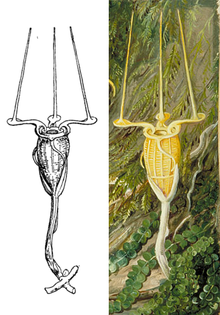| Thismia neptunis | |
|---|---|

| |
| Left: Beccari's original illustration. Right: North's painting based on the original illustration. | |
| Scientific classification | |
| Kingdom: | Plantae |
| Clade: | Tracheophytes |
| Clade: | Angiosperms |
| Clade: | Monocots |
| Order: | Dioscoreales |
| Family: | Burmanniaceae |
| Genus: | Thismia |
| Species: | T. neptunis |
| Binomial name | |
| Thismia neptunis Becc. | |
Thismia neptunis is a species of Thismia endemic to Borneo. It was discovered by Italian botanist Odoardo Beccari in 1866, and described in 1878. It was not observed again until 2017, when it was first photographed by a team of biologists from the Czech Republic. It was found in the Gunung Matang massif in western Sarawak, in the Malaysian part of the island of Borneo.

T. neptunis lives underground, and is a myco-heterotroph, a plant which obtains nutrients through a parasitic relationship with fungi. It does not bloom every year, and when it does, its flower appears above the soil for only a few weeks.
References
- ^ "Thismia neptunis Becc". Plants of the World Online. Royal Botanic Gardens, Kew. Retrieved 2020-12-01.
- ^ Sochor, Michal; Egertová, Zuzana; Hroneš, Michal; Dančák, Martin (2018). "Rediscovery of Thismia neptunis (Thismiaceae) after 151 years". Phytotaxa. 340: 71–78. doi:10.11646/phytotaxa.340.1.5.
- Nelson, Bryan (March 4, 2018). "Weird subterranean plant not seen in 150 years re-emerges from the underworld". Mother Nature Network.
- "Lost plant refound after 151 years", New Scientist: 18, 10 March 2019
- Daley, Jason. "After 150 Years, This Bizarre Plant Was Rediscovered in Malaysia". Smithsonian.com. Retrieved 9 March 2018.
This Dioscoreales-related article is a stub. You can help Misplaced Pages by expanding it. |
This Malaysia-related article is a stub. You can help Misplaced Pages by expanding it. |